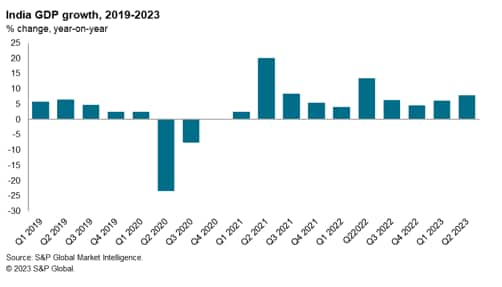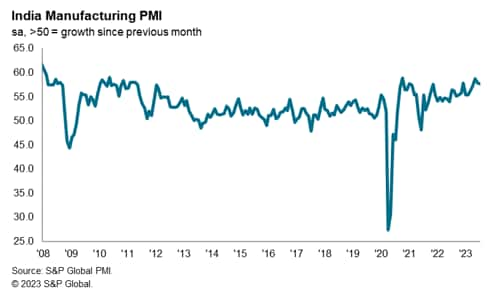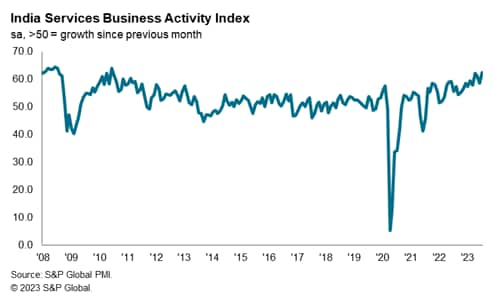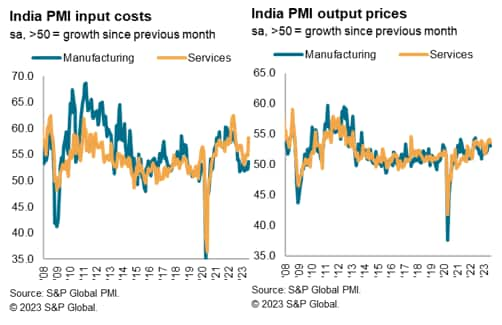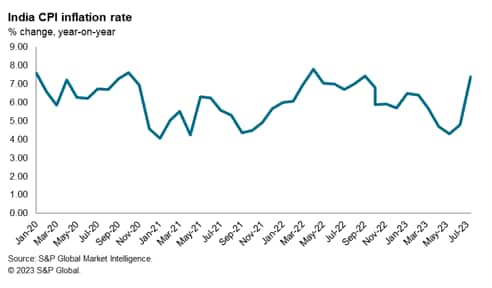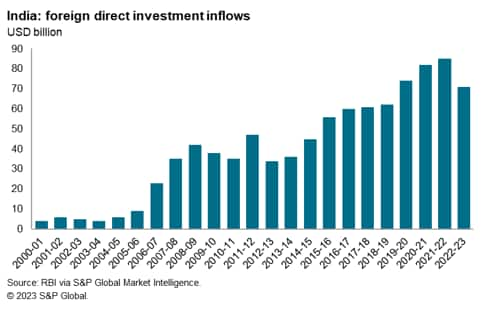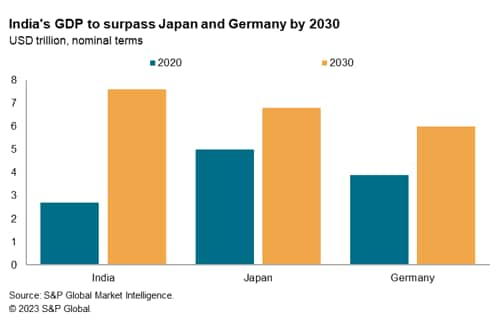Customer Logins
Obtain the data you need to make the most informed decisions by accessing our extensive portfolio of information, analytics, and expertise. Sign in to the product or service center of your choice.
Customer Logins
ECONOMICS COMMENTARY
Sep 08, 2023
India's GDP growth remains buoyant in 2023
India is expected to be the fastest growing nation in 2023 among the G-20 grouping of the world's largest nations that attended the G-20 Leaders' Summit hosted by India in New Delhi on 9th -10th September. After rapid economic growth of 7.2% in the 2022-23 fiscal year, economic momentum has remained strong in the April-June quarter of 2023, with GDP growth of 7.8% year-on-year (y/y). The S&P Global India Services PMI Business Activity Index for August also signalled continued rapid positive momentum for output and new orders, while the August Manufacturing PMI survey showed strong expansion.
India has also become an increasingly attractive location for multinationals across a wide range of industries, with foreign direct investment inflows (FDI) having reached a new record high of USD 85 billion in the 2021-22 fiscal year.
India's rapid economic expansion continues in mid-2023
India's GDP growth rate rose to a pace of 7.8% y/y in the April-June quarter of 2023, compared with growth of 6.1% y/y in the January-March quarter of 2023, according to data released by India's National Statistical Office. The strong growth rate was despite high base year effects after GDP growth of 13.1% y/y in the April-June quarter of 2022.
Private consumption grew by 6.0% y/y in real terms in the April-June quarter of 2023, improving on the 2.8% y/y pace of growth recorded in the January-March quarter.
Gross domestic fixed capital formation remained strong, growing at a pace of 8.0% y/y in the April-June quarter of 2023 compared with 8.9% y/y growth in the January-March quarter of 2023 and buoyant growth of 20.4% y/y in the April-June quarter of 2022.
Construction output rose by 7.9% y/y in the April-June quarter of 2023 compared with the 10.4% y/y growth rate in the January-March quarter of 2023, still showing firm expansion despite high base year effects after growth of 16.0% y/y in the April-June quarter of 2022.
Rapid growth was also evident in key segments of the service sector, with output in the financial, real estate and professional services sector growing by 12.2% y/y in the April-June quarter, while output in trade, hotels, transport and communications services up by 9.2% y/y.
However, manufacturing growth was at a more moderate pace of 4.7% year over year in the April-June quarter of 2023, compared with growth of 6.1% year over year in the April-June quarter of 2022.
Other recent economic indicators for India also continue to signal expansionary economic conditions driven by domestic demand. Steel production rose by 11.9% y/y in the April-June quarter, while consumption of steel rose by 10.2% y/y. Cement production also showed strong growth, rising by 12.2% y/y in the April-June quarter, while coal production rose by 8.7% y/y. Sales of commercial vehicles rose sharply higher in FY2022-23, increasing by 34.3% y/y, while sales of private vehicles rose by 18.7% y/y in FY2022-23.
The index of industrial production, which generally shows considerable monthly volatility, recorded growth of 4.5% y/y in the April-June quarter, while manufacturing output rose by 4.7% y/y in the same quarter. For the FY2022-23 from April to March, industrial production was up 5.2% y/y, with manufacturing output rising by 4.7% y/y over the same period.
For FY2022-23, production of capital goods rose by 12.9% y/y, while production of infrastructure and construction goods rose by 12.5% y/y. However, production of consumer durables and non-durables was sluggish, with production of consumer durables growing at a marginal pace of 0.6 y/y in FY2022-23-23 while consumer non-durables grew by 0.5% y/y, according to the National Statistical Office.
In the April-June quarter of 2023, production of capital goods rose by 4.9% y/y, while production of infrastructure and construction goods rose by 14.0% y/y. Output of consumer durables remained weak, contracting by 2.8% y/y, although output of consumer non-durables showed strong momentum, rising by 6.7% y/y.
The seasonally adjusted S&P Global India Manufacturing Purchasing Managers' Index (PMI) rose from 57.7 in July to 58.6 in August, indicating the second-best improvement in the health of the sector for nearly three years.
Demand strength was pivotal to August's robust performance, spurring the fastest upturn in new orders since January 2021. Competitive pricing and advertising were also cited as factors behind sales growth. International sales added to manufacturers' total order books. Not only did new export orders increase for the seventeenth month running halfway through the second fiscal quarter, but also to the greatest extent since November 2022. Panel members reported having secured new work from clients in Bangladesh, China, Malaysia, Singapore, Taiwan and the US.
Despite falling from 62.3 in July to 60.1 in August, the seasonally adjusted S&P Global India Services PMI Business Activity Index indicated one of the strongest increases in output seen since mid-2010. Survey participants mentioned positive consumer appetite, favourable market conditions and successful events. Notably, services firms indicated the sharpest upturn in new export business since the series started in September 2014. Asia Pacific, Europe, North America and the Middle East were among the sources of sales gains reported by panellists. Total new business increased for the twenty-fifth month in a row during August.
However, India's exports of goods and services for the April-July 2023 period contracted by 6.0% y/y, due to a significant decline in merchandise exports of 14.5% y/y in the April-July quarter. The decline of merchandise exports was mitigated by strong growth in services exports, which rose by 7.8% y/y over the same period.
Inflationary conditions
The overall rate of input price inflation remained above that seen for output charges, despite easing since July. The rate of increase was the second-fastest in over a year and above its long-run average. Monitored companies suggested that food, input and labour costs all rose over the course of August.
The latest statistics on India's consumer price index (CPI) showed that the headline CPI inflation rate surged further to 7.4% y/y in July from a pace of 4.8% y/y in June.
A key factor contributing to the upturn in the headline CPI inflation rate was a further sharp upturn in the food and beverages CPI subindex. The food and beverages CPI subindex rose by 10.6% y/y in July compared with 4.6% y/y in June driven by a surge in vegetables prices, as well as significant price rises for cereals and pulses.
The vegetables CPI subindex had registered significant declines in recent months, falling by 8.2% y/y in May after a decline of 6.5% y/y in April. However, in July vegetables prices rose by 37.3% y/y. A significant contributing factor to the sharp upturn in vegetable prices was a sharp rise in tomato prices, due to crop damage in some regions. Prices for pulses also showed a strong increase, rising by 13.3% y/y in July. A key concern for the Indian government has also been rapid rises in rice prices, with the overall cereals sub-index up by 13.0% y/y.
High energy prices have been an important factor contributing to India's CPI inflation pressures over the past year, but have been easing in recent months, helped by some moderation in world oil prices as well as the impact of base- year effects owing to the spike in world oil prices a year ago, in the second quarter of 2022. The fuel and light subindex increase moderated further in July, to 3.7% y/y, compared with 3.9% y/y in June and significantly lower than the 8.9% y/y rate recorded in March.
The Reserve Bank of India (RBI) in its August Monetary Policy Statement raised its projected CPI inflation rate for the current fiscal year (2023-24) to 5.4%, compared with its 5.1% year-over-year projection made in the June Monetary Policy Statement. This nevertheless represents a significant moderation from the 6.5% rise in CPI inflation in fiscal year 2022-23. The near-term trajectory of CPI inflation is projected in the RBI August Monetary Policy Statement at 6.2% y/y for the July-September quarter, 5.7% y/y for the October to December quarter of fiscal 2023-24, moderating to 5.2% y/y in the January-March quarter of 2024, based on the assumption of a normal monsoon.
The RBI's August Monetary Policy Statement had expected that the headline CPI inflation rate would likely witness a spike in coming months on account of disruptions to food production due to adverse weather conditions. The RBI also noted risks to food production from the impact of the skewed south-west monsoon so far, as well as upward pressures on food prices due to a possible El Niño event as well as geopolitical hostilities.
The RBI projection in its August Monetary Policy Statement for real GDP growth for fiscal year 2023-24 remained unchanged at 6.5%. Domestic economic activity is assessed by the RBI to have remained resilient in the April-June quarter of fiscal year 2023-24, as reflected in high-frequency indicators such as passenger vehicle sales and domestic air passenger traffic, as well as steel consumption and cement output. The index of industrial production grew at a pace of 4.5% y/y in the April-June quarter, while core industries output rose by 8.2% y/y in June.
Foreign direct investment
Net new foreign direct investment into India has risen very rapidly in recent years, with FDI reaching a new record level of USD 85 billion in the 2021-22 fiscal year, after inflows of USD 82 billion in the previous 2020-21 fiscal year. Although FDI inflows moderated to USD 71 billion in the 2022-23 fiscal year, this compares with FDI inflows of just USD 4 billion in the 2003-04 fiscal year.
The sustained large FDI inflows over the past decade have helped to reduce India's external account vulnerability and have contributed to boost India's foreign exchange reserves.
A key contributor to strong FDI inflows over the past decade has been technology related FDI, which has become an important source of investment. The Computer Software and Hardware sector was the largest recipient of foreign direct investment equity inflows in the 2021-22 fiscal year, at around 25% of the total inflows.
US technology firms have been a key source of recent FDI inflows into India. In 2020, Google established the "Google for India Digitization Fund", through which it announced plans to invest USD 10 billion into India over seven years through a mix of equity investments, partnerships, and operational, infrastructure and ecosystem investments. Also in 2020, Facebook announced an investment of USD 5.7 billion in Jio Platforms, owned by Reliance Industries Limited.
Infrastructure investments have also been an important sector for FDI inflows. A large FDI deal in 2020 was the USD 3.7 billion investment by Singapore's GIC and Canada's Brookfield Asset Management in the acquisition of Tower Infrastructure Trust, which owns Indian telecom towers assets.
In the 2020-21 fiscal year, FDI from Saudi Arabia also rose sharply, reaching USD 2.8 billion. Saudi Arabia's Public Investment Fund acquired a USD 1.5 billion stake in Jio Platforms and a USD 1.3 billion stake in Reliance Retail in 2020.
Reliance Retail also received investment from other foreign firms in 2020, with Singapore's GIC and TPG Private Capital having invested a combined amount of USD 1 billion, while US private equity firm Silver Lake Partners also invested USD 1 billion.
By source of origin of FDI inflows, Singapore, Mauritius and United Arab Emirates were three of the four top sources of FDI inflows into India in FY 2022-23, alongside the USA. This highlights the growing importance of India's bilateral economic and investment relationships with global financial hubs in emerging markets, in addition to strong ties with advanced economies like the USA, Japan, EU and UK.
The rapid growth in numbers of Indian unicorns (start-ups that have achieved a valuation of over USD 1 billion) over the past five years has also become a major focus for foreign direct investment inflows into India. By mid-2023, there were an estimated 108 Indian unicorns, with 44 of these having reached unicorn status within the 2021 year and 21 in the 2022 year, according to Invest India, the National Investment Promotion & Facilitation Agency.
Indian economic outlook
After two years of rapid economic growth in 2021 and 2022, the Indian economy has continued to show sustained strong growth during the first half of the 2023 calendar year. The near-term economic outlook is for continued rapid expansion during the second half of 2023 and for 2024, underpinned by strong growth in domestic demand.
The acceleration of foreign direct investment inflows into India over the past decade reflects the favourable long-term growth outlook for the Indian economy, helped by a youthful demographic profile and rapidly rising urban household incomes. India's nominal GDP measured in USD terms is forecast to rise from USD 3.5 trillion in 2022 to USD 7.3 trillion by 2030. This rapid pace of economic expansion would result in the size of the Indian GDP exceeding Japanese GDP by 2030, making India the second largest economy in the Asia-Pacific region. By 2022, the size of Indian GDP had already become larger than the GDP of the UK and also France. By 2030, India's GDP is also forecast to surpass Germany.
The long-term outlook for the Indian economy is supported by a number of key growth drivers. An important positive factor for India is its large and fast-growing middle class, which is helping to drive consumer spending. The rapidly growing Indian domestic consumer market as well as its large industrial sector have made India an increasingly important investment destination for a wide range of multinationals in many sectors, including manufacturing, infrastructure and services.
The digital transformation of India that is currently underway is expected to accelerate the growth of e-commerce, changing the retail consumer market landscape over the next decade. This is attracting leading global multinationals in technology and e-commerce to the Indian market.
By 2030, 1.1 billion Indians will have internet access, more than doubling from the estimated 500 million internet users in 2020. The rapid growth of e-commerce and the shift to 4G and 5G smartphone technology will boost home-grown unicorns like online e-commerce platform Mensa Brands, logistics startup Delhivery and the fast-growing online grocer BigBasket, whose e-sales have surged during the pandemic.
The large increase in FDI inflows to India that has been evident over the past five years is also continuing with strong momentum evident even during the pandemic years of 2020-2022. India's strong FDI inflows have been boosted by large inflows of investments from global technology MNCs such as Google and Facebook that are attracted to India's large, fast-growing domestic consumer market, as well as a strong upturn in foreign direct investment inflows from manufacturing firms.
Overall, India is expected to continue to be one of the world's fastest growing economies over the next decade. This will make India one of the most important long-term growth markets for multinationals in a wide range of industries, including manufacturing industries such as autos, electronics and chemicals to services industries such as banking, insurance, asset management, health care and information technology.
Access the India Manufacturing PMI press release and Services PMI press release.
Rajiv Biswas, Asia Pacific Chief Economist, S&P Global Market Intelligence
Rajiv.biswas@spglobal.com
© 2023, S&P Global. All rights reserved. Reproduction in whole
or in part without permission is prohibited.
Purchasing Managers' Index™ (PMI®) data are compiled by S&P Global for more than 40 economies worldwide. The monthly data are derived from surveys of senior executives at private sector companies, and are available only via subscription. The PMI dataset features a headline number, which indicates the overall health of an economy, and sub-indices, which provide insights into other key economic drivers such as GDP, inflation, exports, capacity utilization, employment and inventories. The PMI data are used by financial and corporate professionals to better understand where economies and markets are headed, and to uncover opportunities.
This article was published by S&P Global Market Intelligence and not by S&P Global Ratings, which is a separately managed division of S&P Global.
{"items" : [
{"name":"share","enabled":true,"desc":"<strong>Share</strong>","mobdesc":"Share","options":[ {"name":"facebook","url":"https://www.facebook.com/sharer.php?u=http%3a%2f%2fprod.azure.ihsmarkit.com%2fmarketintelligence%2fen%2fmi%2fresearch-analysis%2findias-gdp-growth-remains-buoyant-in-2023-Sep23.html","enabled":true},{"name":"twitter","url":"https://twitter.com/intent/tweet?url=http%3a%2f%2fprod.azure.ihsmarkit.com%2fmarketintelligence%2fen%2fmi%2fresearch-analysis%2findias-gdp-growth-remains-buoyant-in-2023-Sep23.html&text=India%27s+GDP+growth+remains+buoyant+in+2023+%7c+S%26P+Global+","enabled":true},{"name":"linkedin","url":"https://www.linkedin.com/sharing/share-offsite/?url=http%3a%2f%2fprod.azure.ihsmarkit.com%2fmarketintelligence%2fen%2fmi%2fresearch-analysis%2findias-gdp-growth-remains-buoyant-in-2023-Sep23.html","enabled":true},{"name":"email","url":"?subject=India's GDP growth remains buoyant in 2023 | S&P Global &body=http%3a%2f%2fprod.azure.ihsmarkit.com%2fmarketintelligence%2fen%2fmi%2fresearch-analysis%2findias-gdp-growth-remains-buoyant-in-2023-Sep23.html","enabled":true},{"name":"whatsapp","url":"https://api.whatsapp.com/send?text=India%27s+GDP+growth+remains+buoyant+in+2023+%7c+S%26P+Global+ http%3a%2f%2fprod.azure.ihsmarkit.com%2fmarketintelligence%2fen%2fmi%2fresearch-analysis%2findias-gdp-growth-remains-buoyant-in-2023-Sep23.html","enabled":true}]}, {"name":"rtt","enabled":true,"mobdesc":"Top"}
]}





